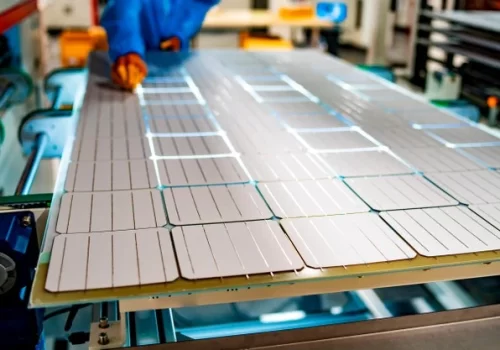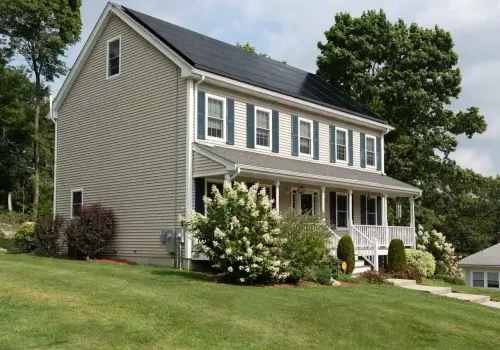Choosing a Solar PV solution is not only good for the environment, it’s good for your business too. Installing a Solar Electric system will allow you to reduce your overheads, generate revenue from your roof and avail of the Accelerated Capital Allowance. Of course, your company will also improve its green rating, reduce its carbon footprint and raise your social responsibility profile within your local community and beyond.

Join the Solar PV revolution! Not only will you enjoy a greener way to power your home, you can also have a good saving on your current electricity bills. Installation is quick and easy! Enjoy a silent, odourless and maintenance-free system that will also improve your home’s BER rating.

Get Started
Request callback or set a meeting
Discussing the requirements
System design as per requirement
The survey will be done & quote will be submit accordingly
Installation
Our team of professionals will install PV as per TS
Start saving
Save energy & your money
Request a Survey & Quote
Benefits
Grants
SEAI (Sustainable Energy Authority of Ireland) offer homeowners a grant to support the installation of Solar PV panels and battery energy storage systems. This will reduce the electricity you currently purchase from your supplier and save you money.
Eligibility
Support is available to all owners of dwellings built and occupied before 2011 and where SEAI have not previously provided support for solar PV system at that address.
The homes energy performance following installation of solar panels must be BER C or better.
Payback estimate
The payback period depends on
- Upfront costs
- Maintenance of the panels
- Amount of sun falling on the panels (South facing panels will produce the most electricity)
- Price paid for the electricity
The typical cost is €1,700 – €2,500 per kWp
Downloads (external links)
Solar PV Scheme Guide
SPV Company Declaration of Insurance
SPV Installer Declaration of Insurance
Code of Practice for Installers
Solar PV Grant Declaration of Works Form
Solar PV Grant Inspection and Testing Report
Solar PV Grant Completion Checklist
Quality Assurance and Development Programme for Solar PV Registered Companies & Registered Installers
FAQs
What will solar PV do for my home?
The panels will generate renewable electricity, which you can use in your home. This will reduce the electricity you currently purchase from your supplier. This reduction in cost from your electricity supplier is a saving directly into your pocket. Solar PV systems are simple to install (typically within a single day), and cause minimal disruption to your home (i.e. no builders work is required).
How long does it take for solar panels to payback the investment?
This depends on several factors like the direction and accessibility of your roof, your location in the country, and the amount you currently pay for your electricity.
What is the right size solar PV system for my home?
The size of solar PV system will depend on a number of factors, and you should discuss this with potential installers. Your installer should consider the amount of electricity you use in your home, when you use it most during the day, and the size, and orientation, of your roof.
It is desirable to maximise the amount of solar electricity you use in your home, sometimes called ‘self-consumption’. You can do this by sizing the solar PV system to meet your demand, and by using energy storage solutions. Analysis of Irish homes found that 80% of the electricity generated by a 2kW (kilowatt) solar PV system in an average Irish home would be used within the home (self-consumed). With the addition of storage solutions, this could be increased further towards 100%.
Therefore, for solar PV without storage, a system of 2kW or lower is considered optimal for high self-consumption. For systems larger than 2kW, some form of storage should be considered to increase self-consumption.
How can I store excess electricity from a solar PV system?
If you have a well insulated hot water tank (‘immersion’), the best option is to use a diverter to heat hot water with electricity that would otherwise export from your house. This is a very low cost solution, and is considered in the grant support. You should consider your hot water needs in your home, and if you will use the water heated this way.
An emerging solution is the use of a battery storage system. This system will detect when you are exporting energy to the grid, and then will store this energy within a battery within your home. The battery will then feed this stored energy back into your home when you need it next.
What is the right type of battery system for my home?
If you choose to install a battery to increase the amount of solar electricity you use in your home, there are a few considerations which you should discuss with your installer
Battery rating and capacity
Battery storage systems are often provided with a power rating in kilowatts (kW). Storage batteries for a grid connected solar PV storage system are around 1kW to 7kW. This is the capability of the battery to charge (from the PV system) and discharge (to the house).
Battery storage system are also provided with a capacity rating in kilowatt-hours (kWh). A battery’s stated electricity capacity is generally larger than the battery’s actual useable capacity, because:
- All batteries lose some energy in charging and discharging, though some have better ‘charge-discharge efficiency’ than others.
- Most batteries are not designed to be routinely fully discharged. Some have deeper discharge capability than others.
Battery lifetime
A battery’s efficient lifetime depends on the technology and the way the battery is used – on the number of ‘cycles’ that they undergo. Manufacturers generally give an expected lifetime in years and/or in ‘charge-discharge cycles’. For example:
‘Life expectancy = 10 years or 10,000 cycles, whichever is the sooner’
DC and AC coupling
There are two main ways of linking a battery storage system into such a system:
- DC Coupled: the batteries are installed on the same side of the solar inverter as the solar PV panels, they charge from the panels, and their DC energy is only converted to AC when it’s used.
- AC Coupled: the batteries are installed on the grid-side, where the solar PV’s DC has already been converted to AC. A separate inverter converts the AC back to DC for storing in the battery. When the battery discharges, the same separate inverter converts the DC back to AC. This type of battery may allow other functions besides storing solar PV excess electricity, such as storing cheaper night rate electricity to use during the day.
Do I get paid for any energy I export?
It is often a complaint that homeowners do not get paid for selling export electricity to the grid. Export payment schemes are not offered (to new customers) by any Irish energy suppliers currently. It is likely that EU directives will change this in the coming years.
From SEAI’s analysis and research it is clear that it is in your best interest to increase self-consumption of the generated solar energy in your home, ideally to 100%, and the grant scheme is tailored to encourage this. It will always be more valuable to use the energy within your home, than any export payment. For solar PV systems with high self-consumption, an export payment has little impact on the payback time of the system.
Therefore, SEAI recommend that you work with your installer to design your PV system (and storage if applicable), to maximise self-consumption in your home.
About 80% of generated energy from a 2kW solar PV system would be self-consumed (i.e. used on site) in an average Irish home. Using simple technologies such as a hot water diverter, the ‘excess’ energy can be used to heat water in your home and push self-consumption towards 100%.
For solar PV systems over 2kW, self-consumption drops dramatically for the average Irish home. To increase self-consumption for large PV systems, a more comprehensive storage system is required, i.e. a battery.
I already have solar PV or another renewable installed, can I get a grant for a battery?
Yes. You can get €600 grant for a battery system.




